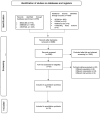Early Enteral Nutrition (within 48 h) for Patients with Sepsis or Septic Shock: A Systematic Review and Meta-Analysis
- PMID: 38892494
- PMCID: PMC11174497
- DOI: 10.3390/nu16111560
Early Enteral Nutrition (within 48 h) for Patients with Sepsis or Septic Shock: A Systematic Review and Meta-Analysis
Abstract
Objective: Medical nutrition therapy provides the opportunity to compensate for muscle wasting and immune response activation during stress and trauma. The objective of this systematic review is to assess the safety and effectiveness of early enteral nutrition (EEN) in adults with sepsis or septic shock.
Methods: The MEDLINE, Embase, CENTRAL, CINAHL, ClinicalTrials.gov, and ICTRP tools were searched from inception until July 2023. Conference proceedings, the reference lists of included studies, and expert content were queried to identify additional publications. Two review authors completed the study selection, data extraction, and risk of bias assessment; disagreements were resolved through discussion. Inclusion criteria were randomized controlled trials (RCTs) and non-randomized studies (NRSs) comparing the administration of EEN with no or delayed enteral nutrition (DEE) in adult populations with sepsis or septic shock.
Results: Five RCTs (n = 442 participants) and ten NRSs (n = 3724 participants) were included. Low-certainty evidence from RCTs and NRSs suggests that patients receiving EEN could require fewer days of mechanical ventilation (MD -2.65; 95% CI, -4.44-0.86; and MD -2.94; 95% CI, -3.64--2.23, respectively) and may show lower SOFA scores during follow-up (MD -1.64 points; 95% CI, -2.60--0.68; and MD -1.08 points; 95% CI, -1.90--0.26, respectively), albeit with an increased frequency of diarrhea episodes (OR 2.23, 95% CI 1.115-4.34). Even though the patients with EEN show a lower in-hospital mortality rate both in RCTs (OR 0.69; 95% CI, 0.39-1.23) and NRSs (OR 0.89; 95% CI, 0.69-1.13), this difference does not achieve statistical significance. There were no apparent differences for other outcomes.
Conclusions: Low-quality evidence suggests that EEN may be a safe and effective intervention for the management of critically ill patients with sepsis or septic shock.
Keywords: critical care; enteral nutrition; sepsis; systematic review.
Conflict of interest statement
The authors declare no conflicts of interest.
Figures






Similar articles
-
Enteral versus parenteral nutrition and enteral versus a combination of enteral and parenteral nutrition for adults in the intensive care unit.Cochrane Database Syst Rev. 2018 Jun 8;6(6):CD012276. doi: 10.1002/14651858.CD012276.pub2. Cochrane Database Syst Rev. 2018. PMID: 29883514 Free PMC article.
-
Early intervention (mobilization or active exercise) for critically ill adults in the intensive care unit.Cochrane Database Syst Rev. 2018 Mar 27;3(3):CD010754. doi: 10.1002/14651858.CD010754.pub2. Cochrane Database Syst Rev. 2018. PMID: 29582429 Free PMC article.
-
Rehabilitation for ankle fractures in adults.Cochrane Database Syst Rev. 2024 Sep 23;9(9):CD005595. doi: 10.1002/14651858.CD005595.pub4. Cochrane Database Syst Rev. 2024. PMID: 39312389
-
Single induction dose of etomidate versus other induction agents for endotracheal intubation in critically ill patients.Cochrane Database Syst Rev. 2015 Jan 8;1(1):CD010225. doi: 10.1002/14651858.CD010225.pub2. Cochrane Database Syst Rev. 2015. PMID: 25568981 Free PMC article.
-
Nutritional support for liver disease.Cochrane Database Syst Rev. 2012 May 16;2012(5):CD008344. doi: 10.1002/14651858.CD008344.pub2. Cochrane Database Syst Rev. 2012. PMID: 22592729 Free PMC article.
Cited by
-
The Gut Microbiome in Sepsis: From Dysbiosis to Personalized Therapy.J Clin Med. 2024 Oct 12;13(20):6082. doi: 10.3390/jcm13206082. J Clin Med. 2024. PMID: 39458032 Free PMC article. Review.
-
Machine learning-based predictive model for enteral nutrition-associated diarrhea in ICU patients and its nursing applications.Front Nutr. 2025 Jun 25;12:1584717. doi: 10.3389/fnut.2025.1584717. eCollection 2025. Front Nutr. 2025. PMID: 40635902 Free PMC article.
-
Comparison of Early Enteral Nutrition Versus Early Parenteral Nutrition in Critically Ill Patients: A Systematic Review and Meta-Analysis.Nutrients. 2024 Dec 24;17(1):10. doi: 10.3390/nu17010010. Nutrients. 2024. PMID: 39796444 Free PMC article.
-
Association between early enteral nutrition and 28-Day mortality in mechanically ventilated patients with sepsis: a retrospective analysis of the MIMIC-IV database.BMC Infect Dis. 2025 Apr 29;25(1):628. doi: 10.1186/s12879-025-10912-8. BMC Infect Dis. 2025. PMID: 40301801 Free PMC article.
-
Development a risk prediction nomogram for multidrug-resistant bacterial and fungal infection in gastrointestinal fistula patients during the perioperative period.Front Cell Infect Microbiol. 2024 Nov 28;14:1502529. doi: 10.3389/fcimb.2024.1502529. eCollection 2024. Front Cell Infect Microbiol. 2024. PMID: 39669267 Free PMC article.
References
-
- Singer M., Deutschman C.S., Seymour C.W., Shankar-Hari M., Annane D., Bauer M., Bellomo R., Bernard G.R., Chiche J.-D., Coopersmith C.M., et al. The Third International Consensus Definitions for Sepsis and Septic Shock (Sepsis-3) JAMA. 2016;315:801–810. doi: 10.1001/jama.2016.0287. - DOI - PMC - PubMed
-
- Evans L., Rhodes A., Alhazzani W., Antonelli M., Coopersmith C.M., French C., Machado F.R., Mcintyre L., Ostermann M., Prescott H.C., et al. Surviving sepsis campaign: International guidelines for management of sepsis and septic shock 2021. Intensive Care Med. 2021;47:1181–1247. doi: 10.1007/s00134-021-06506-y. - DOI - PMC - PubMed
-
- WHO . Global Report on the Epidemiology and Burden of Sepsis: Current Evidence, Identifying Gaps and Future Directions. World Health Organization; Geneva, Switzerland: 2020. [(accessed on 6 May 2024)]. Available online: https://iris.who.int/bitstream/handle/10665/334216/9789240010789-eng.pdf....
-
- Compher C., Bingham A.L., McCall M., Patel J., Rice T.W., Braunschweig C., McKeever L. Guidelines for the provision of nutrition support therapy in the adult critically ill patient: The American Society for Parenteral and Enteral Nutrition. J. Parenter. Enter. Nutr. 2022;46:12–41. doi: 10.1002/jpen.2267. - DOI - PubMed
Publication types
MeSH terms
LinkOut - more resources
Full Text Sources
Medical

